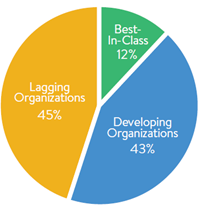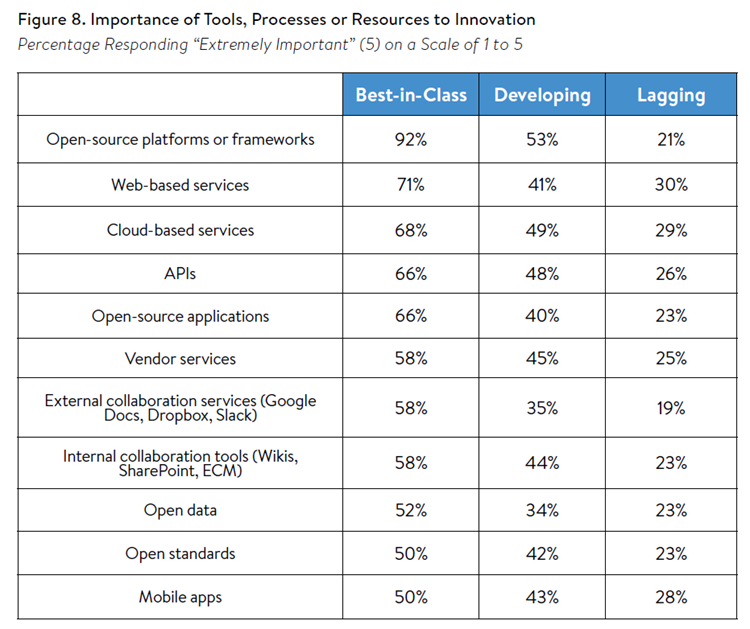Alfresco & Forbes Insights Reveal 3 Levers to Digital Transformation
In today’s ever-changing technology landscape, remaining still essentially means going  backward, thus, it is not possible for businesses to live in digital denial anymore. Even though a recognition of the need of digital transformation once was an issue, it isn't today, as finally, the majority of businesses consider digital transformation critical or extremely important. So one would think that today’s organizations are already delivering better digital abilities. Well, unfortunately, that’s not entirely true. The problem is that most leaders have an outdated perception of what digital transformation means, and this situation causes their organizations to seem decades behind their outperforming rivals who excel at digitally transforming.
backward, thus, it is not possible for businesses to live in digital denial anymore. Even though a recognition of the need of digital transformation once was an issue, it isn't today, as finally, the majority of businesses consider digital transformation critical or extremely important. So one would think that today’s organizations are already delivering better digital abilities. Well, unfortunately, that’s not entirely true. The problem is that most leaders have an outdated perception of what digital transformation means, and this situation causes their organizations to seem decades behind their outperforming rivals who excel at digitally transforming.
Then, what does separate the winners from the losers in this rapidly changing environment? To address this question Forbes Insights conducted a report entitled “The Great Rethink: How Digital Leaders Are Building Tomorrow’s Organizations” in association with Alfresco, an enterprise open-source software. As a result of interviewing over 300 top-tier executives, the study found that there are three levers that catalyze a rethinking of the way organizations leverage technology:
-
Design thinking where a relentless focus on optimizing user experience and customer experience guides all business technology decisions.
-
Open thinking in which innovation from both inside and outside the organization is encouraged to drive new initiatives.
-
Platform thinking where the desired outcome of systems and solution deployment is to build an ecosystem of partners and customers that exchange capabilities and data in a manner that creates added value.
Identified as Best-in-Class enterprises, organizations that adopt all three of these levers are claimed to be the most forward-looking in the markets they serve, according to the report. In light of these descriptions, let’s dive into the other significant findings retrieved from this study:
-
64 percent of Best-in-Class firms report annual earnings growth exceeding 10% over the  past three fiscal years while 43 percent of those still developing their capabilities across one or two of the three key areas. Only 19 percent of those who have not yet embraced design, open or platform thinking are experiencing such growth.
past three fiscal years while 43 percent of those still developing their capabilities across one or two of the three key areas. Only 19 percent of those who have not yet embraced design, open or platform thinking are experiencing such growth.
-
Open thinking has the lowest adoption rate across the three levers explored in the survey, while design thinking has the strongest adoption, meaning that many organizations closely embrace customer experience (CX) and user experiences (UX), but innovation is still a work in progress for many organizations.
-
Best-in-Class organizations focus their digital engagements on addressing the customer experience and customer satisfaction first.
-
The role of IT is evolving from a back-office function to a leadership position as organizations increasingly embrace digital.
-
58 percent of Best-in-Class organizations strongly agree that they welcome input and ideas from customers to help improve processes; only 37 percent of developing organizations and 15% of their less-advanced counterparts can concur.
-
90 percent of Best-in-Class organizations consider open-source technologies as the best way to keep the movement of ideas inside and outside of their organizations. If you bear with me, I would like to discuss this particular finding shortly in this article.
-
74 percent of executives in Best-in-Class enterprises say their provisioning of services to outside parties will increase significantly over the next three years, versus 43 percent of developing enterprises and only 14 percent of lagging organizations.
-
Two-thirds of Best-in-Class agree that they have a robust agility as they can quickly launch new products and services, often without their IT departments needing to get involved versus only 10 percent of their less-advanced counterparts.
There are more interesting findings depicted via very clear charts in the report.
With Chris Wiborg on Digital Transformation
Last March, when Alfresco announced the biggest platform rollout in the company’s history, we had interviewed Chris Wiborg, Vice President of Product Marketing at Alfresco. During that interview, he had concisely explained the three milestones of content management, saying that the first phase was understanding the concept of digitalization, where people moved away from the analog world to structure things into a digital format. After the first phase was consumed, he told that we entered into the second phase, where businesses focused on serving up the right content at the right time, and he concluded that the business world now is approaching the third phase which is the quest for digital transformation.
had interviewed Chris Wiborg, Vice President of Product Marketing at Alfresco. During that interview, he had concisely explained the three milestones of content management, saying that the first phase was understanding the concept of digitalization, where people moved away from the analog world to structure things into a digital format. After the first phase was consumed, he told that we entered into the second phase, where businesses focused on serving up the right content at the right time, and he concluded that the business world now is approaching the third phase which is the quest for digital transformation.
Based on this nicely portrayed evolution of content management, I wanted to pick Chris’ brain once again on digital transformation. Here is what he had to say:
What are the most fundamental elements to extracting the full value from digital transformation?
Chris: There’s no silver bullet here as every company is different – but we’ve consistently seen that adopting the principles of design thinking, open thinking and platform thinking are important to help focus on desired outcomes (user experience, solution agility, ecosystem value exchange) that lead to digital success. Of course, another important element is leadership: it’s much easier to “transform” within an organization when such a mindset is supported top-down vs. fighting against internal inertia to effect a change.
In your opinion, is there a brand or brands, you feel excels with their digital transformation strategy?
Chris: Of course, there are digital natives like Amazon (books-> retail anything (Whole Foods!)-> cloud services with AWS) – but also companies that have been around for years such as Capital One or Pitney Bowes (“The Craftsmen of Commerce”) that have done an amazing job evolving from their traditional lines of business to becoming digital-first companies. In some ways, these are really the more interesting ones to look at these days as they’ve had to do the heavy lifting of moving from -> to versus being “born” digital.
Organizations should have a digital outside for a seamless customer experience and a digital inside for operational superiority. Do you think many companies have lagged in one or the other? If so, what, do you think are the steps to succeed both?
Chris: Oh absolutely. For example, it’s not enough just to have an engaging website for customers to order things that is disconnected from the customer service and support experience. Conversely having superior customer service won’t make up for a storefront where it’s hard to find and order what you need. One has to think about the end-to-end customer journey and this begins with the design thinking principle of empathy. Put yourself in your customer’s shoes and walk through what they experience to figure out how to get it right. Think holistically, full lifecycle and outside-in vs. inside out.
Open Source Has Become Sexy Again
When I asked him his brief opinion on the highlights from the report, he specifically emphasized on the findings regarding open source and said: “It’s been interesting to see how important open (open APIs, open standard, open source) has become in this new era. For customers that want to move quickly, it’s clear that proprietary systems of old don’t provide the flexibility and interoperability required to be able to rapidly create – as well as rapidly adapt – solutions being designed to keep up with the pace of change. Open source has become sexy all over again!”
This specific takeaway on innovation and open source from the report had drawn my attention too when I first read the report over as it contends that innovations on creating such agile platforms comes from the concept of ideas flowing across internal and external shareholders. I definitely agree that closely listening to customers and collaborating with technology and solution partners are essentials to get that innovation ball rolling and sustain it. Alfresco, for instance, announced a partnership with Amazon a couple of months ago. According to the vendor, with Alfresco Quick Start, users can build a full production environment and it takes roughly only 42 minutes, meaning that the platform rapidly shrinks the time and effort of deploying Alfresco down from days to a matter of minutes. As a result of this particular partnership, Alfresco had a 150,000-seat deployment up and running in the first six weeks. In addition to this example, today, we increasingly see major tech titans which consistently strive to outpace each other in a cut-throat competition also teaming up to innovate on new platforms and use cases together.
To paddle back to the study again, based on the survey conducted with 328 senior-level executives, representing a range of job functions and industries, the study also provides a breakdown of the tools, processes, and resources that organizations take advantage of to innovate:

My POV
A single, integrated workflow that includes seamless integrations between the right technologies is one of the fundamental elements of a successful digital transformation. However, as I said this is only one aspect of it as digital transformation involves different thinking, innovation, a modification in leadership & new business models and incorporating digital strategy into all aspects of the business to improve the experience of your organization’s employees, customers, suppliers, and partners. While striving to thrive with all of these, time is currency, as things are moving at light speed. There is also this domino effect that happens when so many disruptors are reinventing an industry, the way of doing business in other associated sectors would also change. Because of all these time and resource pressures, one of the most common mistakes that organizations make is following the leader in the markets they serve, instead of developing a digital strategy that is right for them. It may seem a fast and proven method at first glance but it is dangerous. After all, every organization has its own unique culture, needs, and goals. A thorough digital strategy and roadmap makes the process less intimidating while helping leaders steer organizations effectively as they make the transition to becoming more fully digital enterprises.

Venus Tamturk
Venus is the Media Reporter for CMS-Connected, with one of her tasks to write thorough articles by creating the most up-to-date and engaging content using B2B digital marketing. She enjoys increasing brand equity and conversion through the strategic use of social media channels and integrated media marketing plans.